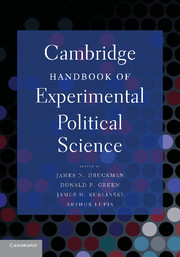Book contents
- Frontmatter
- Contents
- List of Tables
- List of Figures
- Contributors
- Acknowledgments
- INTRODUCTION
- PART I DESIGNING EXPERIMENTS
- PART II THE DEVELOPMENT OF EXPERIMENTS IN POLITICAL SCIENCE
- PART III DECISION MAKING
- PART IV VOTE CHOICE, CANDIDATE EVALUATIONS, AND TURNOUT
- PART V INTERPERSONAL RELATIONS
- PART VI IDENTITY, ETHNICITY, AND POLITICS
- 20 Candidate Gender and Experimental Political Science
- 21 Racial Identity and Experimental Methodology
- 22 The Determinants and Political Consequences of Prejudice
- 23 Politics from the Perspective of Minority Populations
- PART VII INSTITUTIONS AND BEHAVIOR
- PART VIII ELITE BARGAINING
- PART IX ADVANCED EXPERIMENTAL METHODS
- AFTERWORD
- Name Index
- Subject Index
- References
20 - Candidate Gender and Experimental Political Science
Published online by Cambridge University Press: 05 June 2012
- Frontmatter
- Contents
- List of Tables
- List of Figures
- Contributors
- Acknowledgments
- INTRODUCTION
- PART I DESIGNING EXPERIMENTS
- PART II THE DEVELOPMENT OF EXPERIMENTS IN POLITICAL SCIENCE
- PART III DECISION MAKING
- PART IV VOTE CHOICE, CANDIDATE EVALUATIONS, AND TURNOUT
- PART V INTERPERSONAL RELATIONS
- PART VI IDENTITY, ETHNICITY, AND POLITICS
- 20 Candidate Gender and Experimental Political Science
- 21 Racial Identity and Experimental Methodology
- 22 The Determinants and Political Consequences of Prejudice
- 23 Politics from the Perspective of Minority Populations
- PART VII INSTITUTIONS AND BEHAVIOR
- PART VIII ELITE BARGAINING
- PART IX ADVANCED EXPERIMENTAL METHODS
- AFTERWORD
- Name Index
- Subject Index
- References
Summary
The largest literature on gender and experimentation in political science concerns voter reaction to candidate gender. One of the earliest and most enduring questions in the study of gender and politics concerns women's election to office. Because the number of women candidates and officeholders has increased in the United States over the past several decades, there are more cases of women candidates and officeholders available for empirical analysis. Today, women are a majority of the electorate, and women candidates tend to win their races at rates similar to those of men. Yet, the gender gap in candidacy and office holding remains large and stable. Understanding how voter beliefs about candidate gender shape attitudes and political behavior remains an important area for research.
Experimentation has helped scholars overcome some of the limitations of using observational studies to investigate candidate gender. As Sapiro (1981) observed, public opinion surveys may not be able to detect prejudice against women candidates if voters provide socially desirable responses. And if prejudice against women is subconscious, then voters may not even be aware of their attitudes. Observational studies are also limited in helping us understand what we cannot observe, namely, why far fewer women than men seek office. If women fail to run because they fear a gendered backlash from voters, then we are unable to evaluate the experiences of those women.
- Type
- Chapter
- Information
- Cambridge Handbook of Experimental Political Science , pp. 289 - 298Publisher: Cambridge University PressPrint publication year: 2011
References
- 8
- Cited by



